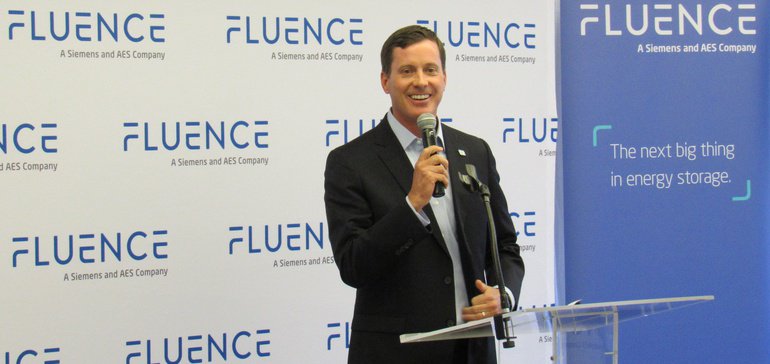
As the storage sector continues to develop, the utility-scale battery joint venture created by tech giants Siemens and AES Corporation is aiming to increase its market share in the commercial and industrial space.
Growing quickly in the nine months since its launch, Fluence expanded to new headquarters on Tuesday in Arlington, Va.
The company is largely known for utility-scale storage projects and replacing peaker plants with batteries in California, but now its leaders are eyeing more opportunities with renewable integration and storage applications for transmission. Its rapid rise, backed by the capital and experience of its parent companies, also enables its leadership to focus on large-scale behind-the-meter (BTM) opportunities.
“I believe transmission is going to be one of the next big things,” Stephen Coughlin, Fluence’s CEO, told Utility Dive. “You can move power around in times of less congestion, store it and then it’s already where it needs to be, and then release it.”
Battery storage: The grid’s Swiss Army knife?
By virtue of being able to capture energy and to feed it back into the grid, battery storage can play a lot of roles. However, as more uses are explored, U.S. regulations have yet to catch up.
“The problem with storage is that it does things that the current regulation doesn’t remunerate,” Andrés Gluski, AES president and CEO, told Utility Dive.
Gluski credits states for putting out legislation that provides the right incentives for storage, noting that it varies state by state.
Arizona, Colorado and Nevada are working on energy storage policies and the proposed targets to help develop the industry.
One issue is that storage largely lacks tax incentives when placed apart from renewables. Rules that would put storage on equal footing with renewable assets would make the top of the regulatory wishlist for Fluence’s chief operating officer, John Zahurancik.
“There are places that you could use energy storage that are in the center of the grid,” not necessarily paired with renewables, Zahurancik told Utility Dive.
And beyond its siting, Gluski pointed out that there are multiple potential capabilities where storage lacks regulations.
“Something as simple as a mandate to consider energy storage and the procurements is very helpful,” Coughlin said.
Coughlin also referred to transmission as an important application of storage.
“There’s a huge role for energy storage in transmission,” Gluski said, “basically allowing you to run the transmission lines closer to their nameplate capacity, rather than having to build out just for peak which may last an hour.”
In Virginia, home to AES and to Fluence’s headquarters, the state is currently working on a goal to cut carbon emissions in the power sector 30% by 2030. The goal, established by former Democratic Gov. Terry McAuliffe, includes an initiative in the state’s voluntary renewable portfolio standard program to use 15% renewable energy in Virginia’s energy mix by 2025.
Current Democratic Gov. Ralph Northam sees a role for storage in the state’s clean energy goals as technology is improving to help store intermittent renewable energy.
“I’ll work with our agencies and I’ll work with our private sector to do everything that we can to move that forward,” Northam told Utility Dive.
Northam, who participated in the ribbon-cutting for Fluence’s new headquarters, did not clarify the specific role energy storage would serve in the 2018 Virginia Energy Plan.
